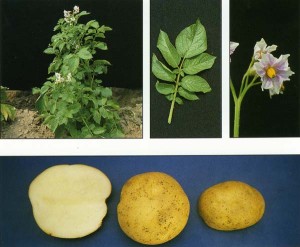Kanona (Solanum tuberosum)
ORIGIN: Kanona arose from a cross made in 1975 between Peconic and a bulk collection of pollen from a group of golden nematode susceptible clones. The variety was first evaluated as T4-20, then as NY71. It was released by Cornell Univers ity in 1989.
CHARACTERISTICS: Kanona is a mid season variety grown primarily for chipping.
Plants are slow emerging, moderate in size and spreading in habit. Leaves are open with small secondary leaflets. Flowers are lavender with white tips extending to center of petal. Fruiting occurs sparsely in the field though the clone can be used as a male or a female in the greenhouse.
Few tubers are produced per plant. They tend to be large and are produced on short stolons. They are spherical with medium deep eyes. Tubers have a white and slightly netted skin.
STRENGTHS & WEAKNESSES: Kanona’s primary advantages are its good chip color at 45 to 50F storage and golden nematode resistance. It is moderately resistant to Verticillium wilt but susceptible to scab, early blight and wart. The specific gravity is greater than Montana but is generally low. Tubers tend to be free of internal defects and cooking quality is good, but tuber appearance detracts from tablestock usage. Tuber dormancy is slightly longer than Katahdin or Monona and it does have good yield potential.
